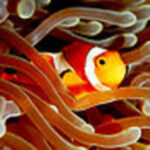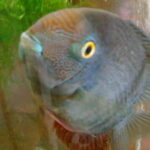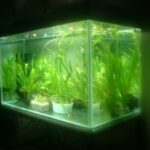With the increased demand and desire to create a tropical fish tank all the way up to a full blown saltwater reef biotope, the African cichlids have taken a backstage presence. This is an unfortunate event as African cichlids represent a whole other realm of fascination in the aquarium hobby. Often considered easier to maintain than tropical fish, Africans come in a vast array of color, patterns and attitude which opens up a whole new aspect and approach to the aquarium hobby.
African cichlids are associated with and hail from three major lakes in Africa: Lakes Victoria, Tanganyika and Malawi. Their are roughly about 1200 species of African cichlids residing in these lakes with many more that are endemic to river regions that help to make up these lake regions. Roughly 1/3 of these fish are available to anyone who is interested in creating an African “rift” environment offering a different and unique type of aquarium.
As for the size of these African fish, the average size is about 4-6 inches as opposed to tropicals that are in the 2-3 inch range, so if larger fish is your fancy, these are what you want! The colors and price are also a positive force to help you make the switch to Africans or start up an African rift tank. Some species such as Haplochromis’, Peacocks, Labidochromis’, and Pseudotropheus are just a few species of fish that will tickle your fancy and make your mouth drop. The vibrant color combinations and contrasts will create a stunningly visual appearance, to offer many hours of enjoyment. The price associated with Africans is comparable to tropicals as well so the average price will be around the $3.00 price point, so the strain and burden on your wallet and pocketbook will not be evident.
With tropical and saltwater fish their is a pretty strict rule of thumb that states that one shouldn’t over crowd their tanks with fish. Roughly 1-2″of fish per gallon of water with tropicals and less than that with saltwater species. With Africans, quite the opposite holds true as if you keep a larger amount of fish in your tank housing Africans, your fish will actually be better off! Africans, for the most part, have a territoriality issue hence their more boisterous nature in the wild. This holds true in captivity, however, by boosting the population Africans in a captive environment, the amount and severity of aggressive behavior portrayed by Africans becomes less. The fact that there are many fish in the tank, Africans have a harder time focusing and keying on each and every fish coexisting within the same tank, moreover, it is harder to obtain dominance or set up a territory parameter with which to call its own. I would go with 5 fish per 10 gallons of tank water as a good starting point and guideline for the best success. Obviously, you will have to take into consideration the size of the fish that you add initially as well as the size attained once they reach adult stages.
To best mimic the African cichlid natural biotope in a captive environment, it is best to limit the amount of plants, live or fake, to a minimum because they will only get uprooted and damaged. The best scenario is to create a “rift” environment containing numerous rock cropping. This is best illustrated by creating a rock wall with many caves, grotto’s and crannies with which African cichlids can retreat when disturbed or scared and call home. This is the type of biotope that most of them live in in the wild, hence the beneficial ramifications by replicating this environment.
African cichlids are very entertaining and enjoyable. Their ease of purchasing and maintaining in a captive environment just adds to their popularity and great choice of aquarium environment. Colors associated with many of these fish combined with their various unique patterns and body structure are other features that add to their desirable point of making great fish inhabitants.
Check out your local pet shop and find out what you have been missing and to view the many species of Africans available to you. Online venues and bookstores will have some great literature to help you to learn about these fascinating fish and enable you to become successful if you do decide to go down the road and create an African rift biotope filled with beauty, wonderment and fascination!







